TWO TERRIFIC ALL WOMAN BANDS | |
Sherrie Maricle and the DIVA Jazz Orchestra (1993 -- ) "Dedicated to keeping big band music alive and swinging because we all have a passion for that music." -- Sherrie Maricle | 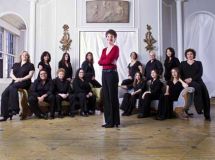  |
Mariachi Reyna de Los Angeles (1994 -- ) At right: performing at the Hollywood Bowl "My teacher told me I couldn't play guitarron because it was too heavy ... some really bullshit excuse." -- Reyna band member Carmen Hernandez | 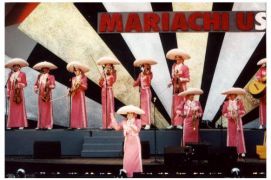  |
Sherrie Maricle and the DIVA Jazz Orchestra Birth of a Band: New York City, 1990 - 1993 |
In 1990, drummer Sherrie Maricle was playing in a band conducted by Stanley Kay, a former manager and relief drummer for the Buddy Rich band. Impressed with her extraordinary talent, Kay wondered if other women players could perform at the same level. In a series of nationwide auditions, band members were chosen, assembled to rehearse, and in March 1993, DIVA made its concert debut. [1] Kay says: “I have always believed that, given the proper training and opportunities, women musicians can be just as good as the best male players. DIVA has proved my point ... and they do it every time they play.” [2] Dozens of jazz critics and reviewers agree. “If there were still big band cutting sessions, DIVA would swing a lot of the remaining big bands out of the place.” – Nat Hentoff, Jazz Times [1] Hear DIVA play Slambo! “DIVA, the explosive, all-women band from the Big Apple, ... crackles with clarity, precision and power.” Owen McNally, Harford Courant. [1] “The concert ended with the sort of bang only a big band can detonate, thanks to DIVA.” Mike Joyce, The Washington Post [2] “To witness DIVA can be a revelation. Stereotypes are blown away. With the possible exception of Ina Ray Hutton’s Melodears in the ‘30s, there has been no professional female big band as together as DIVA.” Mike Zwerin, The International Herald Tribune. [3] In 2006, DownBeat Magazine’s Critic and Reader Polls both voted DIVA one of the best big bands in the world. The DIVA Jazz Orchestra has performed at Carnegie Hall, Lincoln Center, Tanglewood, the Kennedy Center, the Hollywood Bowl, and major jazz festivals in the U.S. and abroad. They have been featured on CBS Sunday Morning with Charles Osgood; CNN Arts Break, on The 25th Anniversary of the Kennedy Center TV Special; the NHK (Japan) Network’s New York Jazz; and in a documentary, The Girls in the Band, set for a 2009 premier. [1] In its 15-year history, more than 100 women (and a few men) have played with DIVA. You’ll meet six of them later in this article, but first, let's shift to Los Angeles and the birth of another all-woman band. | 1990 prices and events Bread: .69/loaf Milk: 2.15/gal Car: $15,492 Gas: $ 1.22/gal House: $149,800 Income: $42,652/year Minimum wage: $3.80/hour President: George Bush Dr Antonia Novello sworn in as first Hispanic/female US surgeon general. Top Books: A Bright Shining Lie, Neil Sheehan; The Journalist and the Murderer, Janet Malcolm Top songs: Vision of Love, Mariah Carey; Vogue, Madonna, Nothing Compares 2 U, Sinead O'Connor In the largest art theft in history, thieves take paintings valued at $500 million from the Isabella Stewart Gardner Museum in Boston. Former Exxon Valdez Captain Joseph Hazelwood ordered to help clean up Prince William Sound and pay $50,000 in restitution for disastrous 1989 oil spill.
"Les Miserables" opens at Shubert Theater in Boston. Academy Awards: Dances With Wolves (best picture); Kathy Bates (best actress, Misery); Jeremy Irons (best actor,Reversal of Fortune) Hot TV shows: Murphy Brown, Roseanne, Cheers, Dallas, The Simpsons. |
Mariachi Reyna de Los Angeles (1994 -- ) |
In 1994, the all-female Mariachi Reyna de Los Angeles, made their debut before an audience of 18,000 at the Hollywood Bowl. The concert was part of an annual Mariachi USA festival begun in 1989 by producer Rodi J. Rodriguez. In 1991 she took the bold step of presenting an all-female mariachi band (pictured at right), directed by Rebecca Gonzales and Laura Sobrino. Hear Mariachi Reyna in San Jose 2007 | 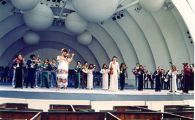  |
It was not the first all-female mariachi band to appear in the United States, but the group won thunderous applause, paving the way for other female mariachi bands. [1] Reyna de Los Angeles was founded by Jose Hernandez, founder and music director of the Grammy-nominated all-male Mariachi Sol de Mexico. In the early 1990s he began teaching mariachi classes in the Los Angeles public schools. Half of his students were girls. “They didn’t really have any role models,” Hernandez said. [2]
In 2008, Reyna de Los Angeles was the subject of a PBS documentary, “Companeras,” but a New York Times article laments: “marriage, motherhood and meager pay [still] get in the way.” [2] Despite their considerable success—Reyna plays at festivals, theaters, fairs and private parties—most members have a “day gig,” working in other professions. Ranging in age from 16 to 42, many members must balance their passion for music with caring for children. Female bands don’t earn as much money as the all-male bands. “We’re lucky if we get half the amount of money we charge for Sol [his all-male band],” Hernandez says. [2] Still, the women follow their passion.
Companera means friend, but “bosom buddy” might be more accurate. Laura Paloma Cordova, Reyna’s harpist says, “When you tell your friend secrets, and she tells you hers ... that’s not a friend, that’s a companera!" [2] The good news: since Reyna made their debut, more than 20 female professional groups have formed in the United States. [3] | 1994 prices and events Bread: .76/loaf Milk: 2.29/gal Car: $18,657 Gas: $ 1.17/gal House: $154,500 Income: $49,340/year Minimum wage: $4.25/hour President: Bill Clinton Ruth Bader Ginsberg sworn in as Supreme Court Justice. Pope John Paul II visits Spain. Millions watch on TV as L.A. police chase OJ Simpson in his Ford Bronco; he surrenders and is charged with murdering his wife, Nicole Brown Simpson, and Ronald Goldman. Disney's "Lion King" opens in movie theaters taking in $42 million the first weekend. Top Songs: Hero, Mariah Carey; The Power of Love, Celine Dion; Breathe Again, Toni Braxton Academy Awards: Forrest Gump (best picture); Jessica Lange (best actress, Blue Sky); Tom Hanks (best actor, Forrest Gump) Hot TV shows: Friends, ER, N.Y.P.D. Blue, Law & Order |
Mariachi: a Mexican cultural tradition |
In the mid-1850s mariachi bands played at rural Mexican fiestas, where couples danced on a wooden platform. By the 1920s mariachi groups were playing in urban centers like Mexico City, the nation's capitol. In the 1930s, phonograph recordings, films and radio popularized mariachi music, bringing it national and international attention. [4] In the late 1950s and early ‘60s, several (all-male) Mexican mariachi groups immigrated to Los Angeles. Los Camperos, founded in 1961 by Nati Cano, became the best known, bringing mariachi music to wider audiences. In 1969 Cano’s restaurant, La Fonda, was the first to showcase a mariachi. Other restaurants quickly followed suit. [4] Mariachi Uclatlan, founded in 1961 at the Los Angeles Institute of Ethnomusicology at UCLA, spurred mariachi education in the United States. Now schools and colleges throughout the Southwest offer classes in mariachi music. After the First International Mariachi Conference in 1979 in San Antonio, mariachi festivals and conferences proliferated in the United States. [4] |
Mariachi instrumentation and uniforms Standard instrumentation for a full mariachi is 2 trumpets, 3 or more violins, vihuela (a small 5-string guitar-like instrument), guitar, and guitarron (a large, fretless, six-string bass version of the vihuela). Show bands often include a percussionist, a harp, and sometimes a flute. One or more of the players double as singers. The players in the first mariachi bands wore uniforms based on outfits worn by horsemen, traje de charro. |
Now male band members wear a more elegant version of the traje de charro: tight-fitting embroidered pants with intricate silver buttons, a waist-length jacket, and a white shirt. Finishing touches include boots, a wide bow tie, a serape (scarf) and a sombrero. [4]
Pictured at right: Mariachi Vargas de Tecalitian | 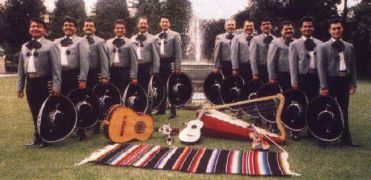  |
Female mariachi uniforms are similar but range in color from black to hot pink. Hear members of of Mariachi Reyna sing the drinking and heart ache song, "Y Andale". At right: 7 members of Reyna de Los Angeles Note the embroidered sleeves and wide bow ties.
Pictured below: two pioneering female mariachis groups that formed in the United States in the 1970's. | 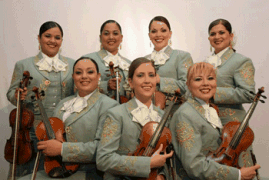  |
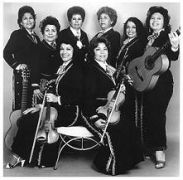  |
At left, Mariachi Las Generales de Los Angeles, 1976
At Right: Mariachi Estrellas de Topeka [Kansas], c. 1979 | 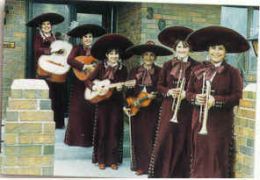  |
Mariachi Repertoire Band members play everything from memory, quite a feat considering that a good mariachi band has a repertoire of 1,000 songs! Female singers evoke the passion of the lyrics. Reminiscent of laments by 1920s blues-women—“Empty Bed Blues” sung by Bessie Smith comes to mind—they plead for a lover to return or berate him for his drinking, betrayals and assorted misbehavior. [3] The music is rooted in more than 150 years of Mexican tradition, a mixture of indigenous, European and African elements. From Europe it borrows dance forms like the waltz and the fandango. From Africa, it borrows dance rhythms and melodic ideas. [10] Some Mariachi Song Types Son Jalisciense: definitive song form of mariachi music. The meter alternates from 6/8 to 3/4 time; some insert 9/8 or 12/8 measures, giving the sense of extra beats. Strong syncopation in the harmony punctuates the melodic line. Ranchera Valsada: 3/4 meter, simple melody, emotional lyrics Huapango: African, Spanish and Indian influences. The meter is often written as alternating 3/4 and 6/8 time. Traditional huapangos are lively and the lyrics raunchy. Ranchera Lento: the most emotional song form: meter is slow 4/4 with bass and guitar alternating beats. Lyrics deal with issues of love and life. Polka: spirited 2/4 time, German influence, usually instrumental, though some have lyrics. Bolero: 4/4 time, ballad style song, typically with romantic lyrics. Danzon: Cuban origins; 4/4 meter with eighth notes played in a 3+3+2 pattern; has a ballroom music flavor; usually played as an instrumental. Paso Doble: derived from Spanish dances; often features trumpet; fast tempos; the feel is that of bullfight music, like La Vergen De La Macarena |
The DIVA Jazz Orchestra Instrumentation, uniforms and repertoire |
The DIVA Jazz Orchestra uses standard big band instrumentation: five saxophones (alto, tenor and baritone), four trumpets, three trombones, acoustic bass, piano and drums. For most gigs, their uniforms are basic-black: long-black trousers with black tops. See photo at right: DIVA members But for special venues, their attire adjusts accordingly. photo below right: the DIVA brass section performs at Yankee Stadium in 2003 | 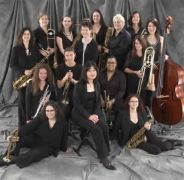  |
Although DIVA draws inspiration from some of the great big bands of the swing era, Count Basie, Woody Herman, Buddy Rich, their arrangements are infused with today’s progressive harmonies. Composed and arranged to fit the individual styles and personalities of the players, the repertoire includes big band standards, jazz standards, Broadway show tunes and original compositions. [1] | 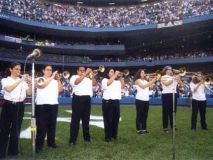  |
Dr. Sherrie Maricle, PhD Leader-drummer of DIVA Jazz Orchestra and her quintet FIVE PLAY |
Composer-performer-educator Sherrie Maricle has won many honors and awards. For example: FIVE PLAY’s 1st recording, On the Brink, was voted #1 CD of 1999 by Nat Hentoff in Jazz Times Magazine. hear Five Play She began studying snare drum in sixth grade in Endicott, New York. When she was eleven, a concert by famed drummer Buddy Rich and his Killer Force Orchestra ignited her “percussive” passion. After earning a B.A. at Binghamton University, she moved to New York City, where she earned an M.A. in Jazz Performance and a Doctorate of Philosophy in Jazz Performance and Composition at New York University. [4] | 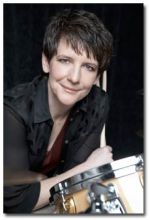  |
Her performances include playing at Carnegie Hall with the New York Pops. She is the orchestra’s Director of Education. An active clinician for Yamaha Drums, Sabian Cymbals and Vic Firth Drum Sticks, Sherrie is a busy freelancer and a published composer/arranger in both the classical and jazz mediums. [4 ] Speaking about DIVA, she says, “We truly love to play and we hope that our love of the music is passed along to the audience. Pleasing the audience pleases us.” She’s also committed to hiring the best available players. “When a substitute is needed, we go for the best player ... regardless of gender, although we are still interested in promoting and hiring qualified women jazz musicians.” [2] | 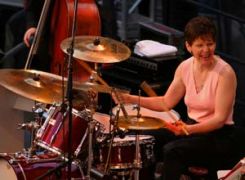  |
All-Female Mariachi Bands: 1940s -- 1970s | ||
All-women big bands performed in the U.S. in the 1920s. All-women mariachi bands arrived much later, especially in the U.S. The earliest documented female mariachi band performed in Mexico City in the mid-1940s. [1] Mariachi Las Coronelas, photo below left in 1949 | ||
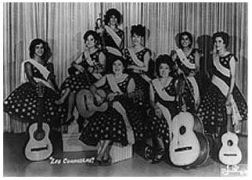  | Other all-female mariachi bands appeared in Mexico during the 1950s and early '60s. [1] Mariachi Las Adelitas, pictured at right c. 1950 | 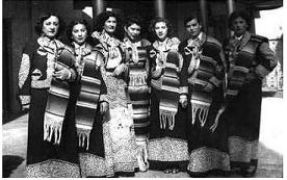  |
In the 1970s two all-female mariachi bands emerged in the United States |
Mariachi Generalas, Los Angeles
In 1976, Maria Elena Munoz decided to form an all-female mariachi group. Her twin goals: to prove women could play mariachi music and have their bands play alongside male mariachi bands. Her son, Juan Matias, performed in some of the top male mariachi groups. He taught the women the mariachi mass (La Misa Panamericana), because their early performances were for Catholic religious services. Next they learned the repertoire required to play at weddings, baptisms, and other celebrations.[1] At Right: Mariachi Generalas de Los Angeles, 1976 | 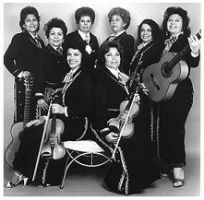  |
By the early 1980s, Maria’s goal had been realized; many women were performing mariachi music in the Los Angeles area. After several members moved to Texas and others retired, Maria disbanded Mariachi Generalas in 1983. [1] | |
Mariachi Estrella, Topeka, Kansas
In 1977, Teresa Cuevas and Consuelo Alcala formed Mariachi Estrella, six women instrumentalists, to sing and play for Catholic masses.
At right: Mariachi Estrella, circa 1977 (Teresa Cuevas, 3rd from the right) They expanded their repertoire to include secular mariachi music, began playing at venues outside the church, and became very popular. Then, a tragedy. | 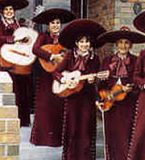  |
In 1981, at a New Year’s engagement at a hotel in Kansas City, the women were crossing a second-story skywalk above the lobby when the skywalk above them collapsed. Four band members were among the 114 people killed. Among the more than 200 who were injured was co-founder Teresa Cuevas, whose spine was crushed. [1] Months later Teresa recovered and continued her quest. She wanted to learn all she could about mariachi violin in order to pass this cultural heritage to her children, grandchildren and others in the community. In junior high, she had played violin well enough to play in the high school orchestra, but when she graduated in the 1930s she couldn’t find a job. She got married, had 5 children, and fell in love with mariachi music. Later, after her children were grown, she divorced. In July 2008, 88-year-old Teresa Cuevas and several of her grandchildren played with her band Mariachi Estrella, now a mixed-gender group, at the 75th Annual Fiesta Mexicana in Topeka, Kansas. As her grandchildren go off to pursue their careers, it will be harder to keep Mariachi Estrella going, but her goal of playing mariachi music with her grandchildren has been realized, a tribute to her indomitable spirit and perseverance. [9] | |
4 members of DIVA and a Distinguished Alumna |
Tanya Darby, lead trumpet “... a virtuoso with remarkable control and power ... who shows that though Miles Davis died in 1991, his unbounded soul will inspire for years to come.” – New York Times (4) Hear Tanya and the DIVA trumpeters play Swing That Music
Even at 12, Tanya had the elements of a mature player. Awestruck audiences at the Monterey Jazz Festival welcomed her youthful talent. Invited to perform with the Festival All Star Band, she became a celebrity with jazz aficionados on the West Coast and in Japan. Playing lead trumpet with the Grammy All-Star band brought her to New York City. [4] | 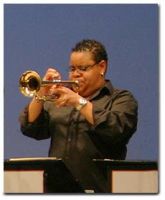  |
Tanya earned a Bachelor’s in Jazz Performance at the Manhattan School of Music and received the Jon Faddis Award for Musical Excellence as Most Promising Jazz Trumpet of the Year. A member of DIVA since 1997, she has performed with Clark Terry, Diane Reeves, Ramsey Lewis, and other jazz greats. As a member of the Thelonious Monk Sextet she appeared on the TV show “BET on Jazz” and on NBC-TV with Aretha Franklin for Arista Records' Twenty-five Year Anniversary Special. Performances with Nancy Wilson, Joe Williams, Diane Schurr and Dave Brubeck took her to notable venues in the US and jazz festivals in Montreal, Paris, and Rome. In addition to performing, she acts as producer and writer for various artists and maintains a studio of private students. [4] | |
Sharel Cassity, lead alto saxophone A virtuoso saxophonist and Jazz Legacy Productions recording artist, Sharel tours the world, playing straight-ahead jazz to the delight of fans and critics. “This is why I am here,” she says. “To be working as a jazz musician. It’s the reason I get up in the morning ... what more could I want?” [4] She holds a Bachelors of Music from New School University, a Master of Music from The Julliard School, and has performed with IAJE Sisters in Jazz and Betty Carter’s Jazz Ahead. A versatile woodwind specialist, she’s also plays clarinet, flute, alto flute and piccolo as well as soprano, tenor and baritone saxophones. | 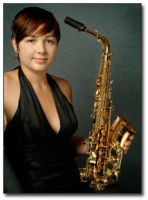  |
Jazziz Magazine said of her playing: "... this altoist's flights are positively Bird-like." [4] Sharel has led small groups at prestigious venues like NBC’s Rainbow Room, Dizzy’s Club Coca-Cola, and the legendary West Village club Smalls. She has played with groups led by Jimmy Heath, Roy Hargrove, Ingrid Jensen and with the Dizzy Gillespie All Stars. Her performances include jazz festivals in the US, Costa Rica, and Hannover, Germany. In 2008, she received the ASCAP Young Jazz composer Award. Originally from Oklahoma City, she now lives in NYC where she teaches privately and for the NY Pops Salute to Music program. [4] |
Leslie Havens, bass trombone A member of DIVA since 1997, Leslie also performs with the Boston Brass Ensemble, Quintessential Brass, Boston theater orchestras, and with classical orchestras in Massachusetts and Rhode Island. As a ten-year member of the Artie Shaw Orchestra she has toured the US, Taiwan and Brazil and appears on their CD, Stardust and Beyond (2006). [4, 7] Leslie was the first woman ever to tour with the Tommy Dorsey Band, traveling through Mexico, Costa Rica, and other Latin American countries. [7] | 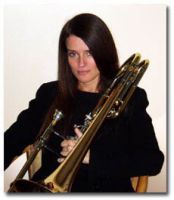  |
"My mother wanted me to play flute, but my 5th grade band director already had too many flute players. He said, 'You want to play trombone, don't you?' He was right. I thought the trombone was cool." She started on tenor but got tired of "fighting over 1st trombone parts" and switched to bass. She grew up in California and came to Boston in 1982 to spend the summer. "I liked it so much, I never went back," she says. [7] Leslie's featured with DIVA in 76 Trombones She has performed in Carnegie Hall with Arturo Sandoval, at the Newport Jazz Festival with Aretha Franklin, and toured the U.S., Canada, Europe and South America with Paul Anka. Besides recording with DIVA, she has recorded with Artie Barsamian’s Boston Big Band, the Jeff Holmes Big Band with Jim Porcella and has appeared with such artists as Tony Bennett, Natalie Cole, Kenny Rogers, Bernadette Peters, Bill Watrous, Phil Wilson and many others. Leslie lives near Boston and teaches Low Brass at several public schools. [7] |
Noriko Ueda, bass While growing up in Hyogo, Japan, Noriko studied classical piano at age 4 and began playing electric bass at 16. She holds a diploma in classical voice from the Osaka College of Music. At 18 she learned to play acoustic bass. A B.E.S.T. scholarship recipient, she majored in Jazz Composition at Berklee College of Music in Boston and received her degree in 1997. Film and TV credits include: Jazz Central, BET (1998) with Groovin’ Girls, an all-Japanese trio; Times Square Transfer, PBS (1999) a musical featuring Noriko on soundtrack and performance; live performance-interview in the documentary, Jamming (1996); and Summa Cum Jazz, a Berklee College of Music CD (BMG 1997) [4] | 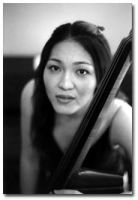  |
Since 1999 she has been a member of the BMI Jazz Composer’s Workshop. As bassist of the Harry Whitaker Project and Victor Jones’ Cultur-Versy, she performs in major NYC jazz venues. Her quartet performed many of her original compositions at the Blue Note in 2002 and 2004. In 2002, Noriko received the Charlie Parker Composition prize from the BMI Foundation for her original piece, Castles in the North. She has lived in Brooklyn, NY, since January 1998, where she continues to perform and compose. [4] |
Distinguished DIVA alumna Liesl Whitaker Lead trumpet, U.S. Army Blues jazz ensemble A “Diva” Becomes “One of the Guys.” So said a headline in U.S. Army Bands News in November 2000. Crossing an unspoken “gender barrier,” Staff Sergeant Liesl Whitaker won the position of lead trumpet in The Army Blues, the premier Army jazz band stationed in Washington, DC. In 1992 Liesl joined DIVA as a charter member and soon earned many fans. “As with any topnotch ensemble, everything starts with the lead trumpet, and DIVA has one of the best in Liesl Whitaker.” - Jack Bowers [5] | 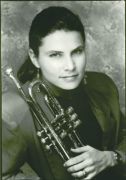  |
Having studied with Bill Adam, Pat Harbison and Joe Phelps, Liesl brings a wealth of musical experience to any group. After attending Appalachian State University and The University of Cincinnati College of Music, she moved to New York City. In addition to DIVA, she played lead trumpet in the Ed Palermo Big Band, performed in Broadway pit orchestras, freelanced and recorded, and taught trumpet at the New York Pops’ Salute to Music Teaching Program. Staff Sergeant Graham Breedlove heard her play with DIVA and invited her to audition for the lead trumpet chair in The Army Blues. At first Liesl’s husband Shaun was reluctant. Having spent 16 years in the British Marines, he wasn’t thrilled about resuming a military lifestyle. But after speaking with Breedlove again and further discussions with Shaun, she decided to audition. [6] There was no doubt in anyone’s mind as to who won the audition. “She won it hands down. We’re thrilled to have her,” said Breedlove, who also plays trumpet in The Army Blues. [5] |
She accepted the job that day, completed 11 weeks of basic training and joined the group. According to the Army, she is the first female to play a lead chair in any military jazz band in Washington, DC. Some of her musician friends thought she was making a big mistake. Liesl disagrees. “I’m not interested in playing the same thing every night for twenty years [on Broadway]. Many people think you’ve got to be in the New York scene to be considered real. I proved that I can hang there and now I’m ready for something new. I think this gig is great.” [5] | 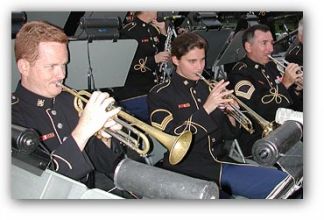  |
Two Mariachi Pioneers: Rebecca Gonzales and Laura Sobrino
|
The first female to play with a high-profile all-male mariachi group, Rebecca Gonzales began classical training on the violin at age 10. Her mariachi studies began in 1972 at San Jose City College with Mark Fogelquist. She joined a local (all-male) group, Mariachi Los Abajenos de Isidro Rivera, continued her violin studies and began singing Mexican songs. [5] At right: Rebecca, 5th from left, with Los Abajenos, c. 1972 | 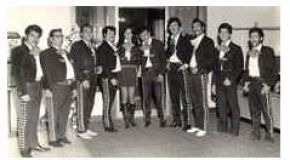  |
In 1972 she entered Cal State San Jose as a music major. In 1975, at Fogelquist’s invitation, she moved to Santa Monica to join Mariachi Uclatlan. In 1976 she became a member of Mariachi Los Camperos, the high-profile all-male show group led by Nati Cano in Los Angeles. She performed with them for 8 years at Cano’s restaurant. |
In 1984, she was invited to perform with Mariachi Cobre at Disney World’s Epcot Center in Orlando, Florida. During the 1990s, she performed with Mariachi Los Gavilanes de Juan Manuel Cortez and sang as a soloist at the Hollywood Bowl in the Mariachi USA festivals (1995 and 1999), and at the Greek Theatre Mariachi Summer Concert in Los Angeles in 1997. At right: Rebecca in uniform with her violin In recognition of her contributions as a role model for women in mariachi, she was inducted into the Mariachi Hall of Fame in 2004. She now performs as a freelance mariachi musician and teaches violin technique in Palos Verdes, California. [5] | 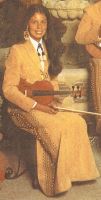  |
Laura Sobrino: Performer, band leader, researcher and teacher
|
Laura Sobrino began playing violin at age eight. While studying for a B.A. in music at UCal-Santa Cruz, she performed with Mariachi Santa Cruz and Mariachi Los Caltecas. After graduation, she moved to Los Angeles and was one of the first women to play in the prestigious (all-male) Mariachi Los Galleros and Mariachi Sol de Mexico. From 1994 to 1996 she served as the first music director and lead violinist of Mariachi Reyna de Los Angeles. [8]
A statuesque 6-foot-1-inch beauty, Laura says: "To this day, I often hear the comment: 'It's nice to see a girl playing mariachi! How long have you been playing?'" [6] She does extensive research to document female participation in mariachi music and published it widely. [see www.mariachi4u.com] | 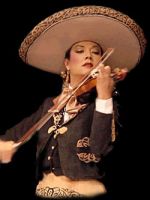  |
In 1995 she formed her own company to publish the mariachi music she transcribes for students. In 2004, she was inducted into the Mariachi Hall of Fame in Tucson. In 2005, California First Lady Maria Shriver selected Laura to be included in the “Latinas: The Spirit of California” exhibit in the California Museum for History, Women & The Arts. [8] Currently she is musical director-violinist for the all-female mariachi show group, Mariachi Mujer 2000. She lives in Whittier, CA, with her husband Dan Sobrino, a pianist and guitarist, and their children. [8] | 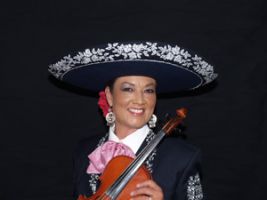  |
COMMENTARY: Performing at the highest level and drawing national and international attention, The DIVA Jazz Orchesta and Mariachi Renya de Los Angeles serve as inspiration to millions of young women in the United States and abroad. Since the 1980s and '90s, acceptance of female jazz musicians in the United States has grown considerably, especially in small-group settings. But most U.S. big-bands are still predominently male, especially those that tour extensively. Mariachi music is even more male-dominated, due to the machismo culture of Mexico. Whereas mariachi music has traditionally been passed from father to son, these days parents feel free to teach children of both genders about mariachi, passing the tradition from father to daughter, or mother to daughter. [6] The musical styles of DIVA and Reyna de Los Angeles may differ, but these women are passionate about their music and it shows. May they have continued success in the years to come! ROLE MODELS and MENTORS: Although all-women big bands in the U.S. date back to the 1920s, the talented women in these bands received little recognition. Many DIVA members were inspired by male role models. Stanley Kay recognized Sherrie Maricle's talent, realized other women could play at the same level, set out to find them and founded DIVA. Critics quickly embraced this talented group. Reyna de Los Angeles members' only female role models and mentors were Rebecca Gonzales and Laura Sobrino. Most of their mentors were male: Mark Foglequist, Jose Hernandez, Nati Cano, and the leaders of other all-male mariachi bands who hired Rebecca and Laura to play with them. OBSTACLES: Traditionally, male mariachis have a reputation for drinking, loving, and then disappearing. A "proper" Mexican woman doesn't marry a mariachi, much less become one. [11] Husbands of the women in Mariachi Las Generalas (1976) told them they were "making fools of themselves." Some women quit because of the stress. One husband broke his wife's trumpet. Another broke a guitar. Still, other women band members persevered. [1] Soon after Laura Sobrino became the 1st female member of the all-male Mariachi Los Galleros in 1979, she was promoted to first violin. A male violinist protested: "I've played mariachi music for 50 years and I've never followed a woman." He left the group, but eventually came back, accepted Sobrino as leader and they became friends. [4] Reyna player Carmen Hernandez says, "My teacher told me I couldn’t play guitarron because it was too heavy ... some really bullshit excuse.” Bandmate Karla Tovar adds, “When you look at the trumpet and the guitarron, those are male instruments ... you’re not encouraged to learn those.” [7] In sly rebuttal, the lyrics of one Reyna song are ... "I want a man, not a potbellied macho." [2] Members of one all-female mariachi band based in Mexico say they receive wider acceptance in the U.S. than in Mexico. Alma Rocio Corona, founder in 1989 of Las Perlitas Tapatias de Mexico says: "Here we've had women tell us 'right on!' and 'great job.' One woman even asked me if I would teach her granddaughter!" [11] Although professional all-female mariachi bands are still scarce, student bands are proliferating. Now it's not uncommon for a girl to tell her parents: "I want to be a mariachi musician when I grow up." Laura Sobrino believes more female mariachi bands will attract national attention soon. "In 10 or 15 years we'll have taken mariachi music to its next step," she says. [11] |
DISCOGRAPHIES | |
DIVA Live From Jazz at Lincoln Center's Dizzy's Club Coca-Cola, 2008. TNT - Tommy Newsom Tribute, 2005 Live in Concert, 2002 I Believe in You, 1999 Leave It To DIVA, 1997 Watch more of DIVA on YouTube: 23rd Annual Jazz Festival at New Trier H.S. Jazz Festival 2008 and Live at Birdland! | Reyna de Los Angeles Companeras, a 2008 PBS documentary on Mariachi Reyna de Los Angeles Solo Tuya, CD 1998 Besame Mucho, undated cassette Listen to Mariachi Reyna on YouTube! Soundcheck for 15th anniversary show Many individual DIVA and Reyna players have solo CDs. |
SOURCES DIVA and Reyna sources are listed separately below SOURCES: DIVA 1. About the band, DIVA website 2. "DIVA: Keeping the Big Band Tradition Alive," Mike Hennessey, Jazz Now, September 2003 3. “Diva Blows Away Cliches of Women in Jazz: From Big Band, Distaff Notations,” Mike Swerin, International Herald Tribune, January 16, 2002 4. DIVA personnel, DIVA website 5. “Diva” Becomes “One of the Guys,” Staff Sergeant Suzette L. Niess, U.S. Army Bands News, November 27, 2000 6. “Liesl Whitaker, Diva trumpeter leads Army Jazz,” Sarah Ing, Windplayer #62 7. Email interview with Leslie Havens, February 2009 SOURCES: REYNA DE LOS ANGELES 1. "A Look at the History of Women in Mariachi Music," Laura Sobrino, 2003, www.mariachi4u.com 2. “A Mariachi Band Sings Its Way Through Traditional Male Turf," Mireya Navarro, NY Times, 4-1-2008 3. "The Queens," Kamren Curiel, Los Angeles City Beat, April 30, 2008 4. "Mariachi: The Sound of Mujeres," Teresa Puente, February 2009, TheLatinaVoz.com—National Online Latina Magazine. 5. Rebecca Gonzales, San Jose International Mariachi Festival biography 6. “The Pioneer Female Mariachis in the U.S. 1970’s,” Laura Sobrino, MENC Mariachi Newsletter, November 2007
7. “Mariachi Queen Laura Sobrino and her band are breaking barriers,” Michael Quintanilla, Los Angeles Times, The Sunday Profile, September 17, 1995
8. Laura Sobrino, San Jose International Mariachi Festival biography
9. “Mariachi Mama,” Sylvia Maria Gross, Weekend America, July 19, 2008
10. Mariachi Music in America, Daniel Sheehy, Oxford University Press, 2006
11. Mariachi Muchachas (Pink Trajes and all!), Laramie Trevino and Alejandro Betancourt, Latina Magazine, December 1996/January 1997 |
© copyright 2009 Susan Fleet



